Hydrangea Great Star - care features
Large-flowered panicle hydrangea Great Star belongs to the Hortensia family. The homeland of growth is East Asia. The plant is long-lived with good winter hardiness, intensive growth, suitable for cultivation in all regions of our country. Consider the main characteristic of the variety, the rules of planting and care.
- Description of the variety
- Landing rules
- Preparation of planting material
- Place and soil
- Landing technique
- Care features
- Watering
- Top dressing
- Pruning
- Leaving during flowering
- Post-flowering care
- Preparation for wintering
- Reproduction
- Layers
- Cuttings
- Diseases and pests
- Chlorosis
- White rot
- Gray rot
- Powdery mildew
- Spider mite
- Aphid
- Snails and slugs
- Gall nematode
- Application in garden design
- Testimonials
- Useful videos
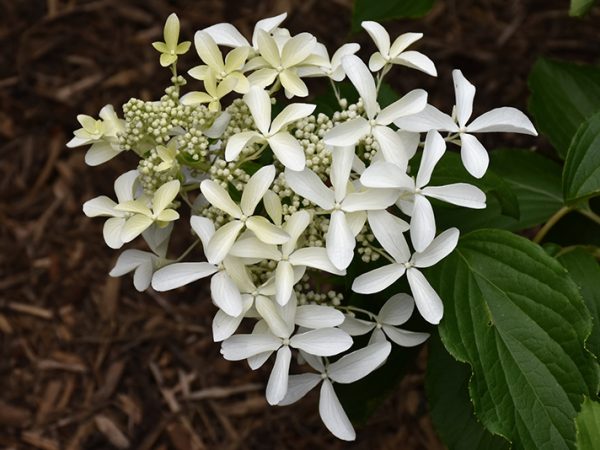
Hydrangea Great Star
Description of the variety
Hydrangea paniculata Great Star is a perennial crop. It has two main qualities - good winter hardiness and high immunity against diseases. Both properties are preserved with proper care and maintenance.
The name in Latin is hydrangea paniculata great star. In translation it means "big star".
In the wild, this shrub reaches 10 m, the cultivated form is compact - from 2.5 to 3 m in height. Crown circumference - 1.5-2 m. Stems are hard, erect, brown.
The root system is well developed, grows rapidly and is close to the soil surface. The leaves are large, oval or rounded with a sharp tip - 10-12x6-7 cm in size. Panicle inflorescences 25 cm in diameter, consist of small female and male flowers. The petals are snow-white, twisted, resembling the shape of the lobes.
Hydrangea blooms in July and blooms in late September or early October.
Landing rules
The key to successful cultivation is high-quality planting material, a good place and nutritious soil.
Depending on the region, the landing time may be different:
- In the North, in Siberia, in the Urals and in the Central zone, spring landing (mid or late April) will be preferable. By this time, frosts will pass, the soil will warm up well.
- In the south and in the middle lane, they are planted in spring and early autumn, but until the last decade of September. If planted later, the seedlings will not have time to take root before the coming cold weather and will freeze.
Preparation of planting material
When choosing a hydrangea in a gardening nursery, pay attention to its appearance. In a strong seedling, all branches are intact with a smooth bark without mechanical injuries, mold, growths.
Leaves and buds are fresh, drained, do not contain yellow, black or brown spots on the surface, as well as signs of drying out.
Buy grown specimens in which the crown consists of 2-3 branches with leaves. Such plants have a well-developed root system, which means they will successfully take root after transplanting to the site.
Give preference to bushes planted in containers or with an earthen lump - their roots are protected from drying out until they are planted in the flower garden.
If you have a seedling with an open root in your hands, you need to put it in cold water for an hour, then immediately plant it, otherwise it will dry out.To stimulate the rapid growth of new roots, it is necessary to trim the rhizome 2-3 cm in length.
Place and soil
Hydrangeas grow successfully in a sunny area, but they do not tolerate direct exposure to rays - the leaves and inflorescences quickly fade.
It is better to plant in an area where there is shade at lunchtime (under tall trees), at a distance of 50 cm from the walls of a house or outbuilding.
Choose a windless, wetland area with fertile, loamy, and well-drained soil. The soil should be acidic, so there is no need to deoxidize it.
You can prepare a soil mixture yourself - mix in equal amounts of humus, garden soil and peat. When planting on heavy loams, sand, vermiculite or perlite is added at the rate of 2 buckets per 1 m².
After all the preparatory work, the site is dug up and leveled.
Landing technique
If you have several bushes, then when planting them, you need to maintain a distance of at least 1.5 m. So the seedlings will fully develop and there will be no competition for moisture, nutrients and space.
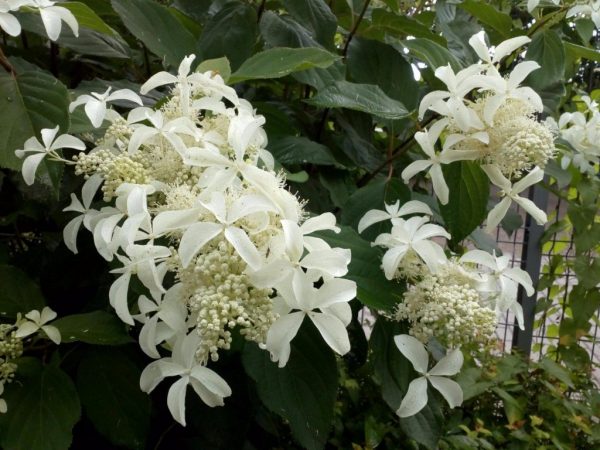
Hydrangea great star description and photo
Pits are dug out a couple of weeks before the planned planting, so that the beneficial components have time to settle. Approximate parameters - 60x70 cm.
The pit is filled with layers:
- the first - 1/3 of the volume consists of a mixture of pebbles, screenings and rubble;
- the second - up to half the depth of the fertile composition - mix the dug garden soil with 20 g of urea, 30 g of potassium sulfate and 150 g of superphosphate.
The roots soaked in water and cut are lowered into the hole so that the root collar is 3-4 cm above the soil surface. All voids are filled with the remaining soil mixture, tamped, watered. Water consumption for one copy is 20 liters.
To prevent rapid evaporation of moisture, the shrub is mulched with a thick layer of peat or last year's manure.
Care features
Watering
Hydrangea should be watered in moderation. Roots rot from frequent overflow, in dry soil they quickly dry out.
In the first month after planting the seedlings, the frequency is every day. This will help them take root faster and start growing.
Further, one should be guided by the state of the earth and seasonal precipitation. If the soil is dry to a depth of 5-6 cm, the shrub should be moistened.
Use settled and warm water to prevent hypothermia of the root system.
After each watering, the soil in the near-stem zone is loosened superficially. Weeds are removed as the weeds grow. Then they add mulch from peat or last year's manure. Both substances provide additional nutrition to the roots and prevent the appearance of unnecessary vegetation in the flower garden.
Top dressing
Without proper nutrition, the perennial shrub grows slowly and blooms sparsely. They begin to feed in the third year of cultivation.
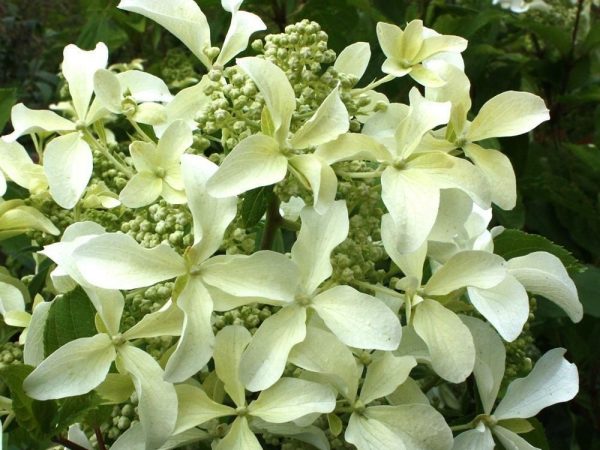
Great star hydrangea
In early spring, nitrogen-containing preparations are introduced, which stimulate the growth of green mass and rhizomes. They use ready-made products - Agricola Aqua, Flower Paradise. If desired, you can prepare the nutritional composition yourself - pour 30 g of superphosphate and 40 g of ammonium sulfate under each bush.
Before flowering in summer, fertilize with a mixture of potassium sulfate (40 g) and superphosphate (60 g). Alternatively, you can use a green dandelion and nettle fertilizer. Fill 1/3 of the bucket with chopped greens, fill it with water, insist for three days. Filtered, diluted with water in a ratio of 10: 0.5 l.
In the fall, when the hydrangea sheds foliage, compost or last year's manure is embedded in the trunk circle. All root dressing is carried out together with watering in order to speed up the process of assimilation of nutrient components.
Additionally, you can feed on the leaf - irrigate the crown with a solution of Epin-extra or Zircon. Three treatments per season are enough - in early spring, before and after flowering.
Pruning
This procedure is carried out twice a year.
- In autumn, faded buds, branches damaged by wind, diseases, parasites are cut off.
- In the spring, they cut out frozen, shriveled shoots, and also shorten the young growth by 1-3 pairs of buds.
Some growers successfully form a shrub on a trunk. First, the strongest stem is chosen, which will later become the central conductor. Each year, new shoots are pinched. After 3 years, they are cut into a ring.
In order for the standard hydrangea to fully develop and have a beautiful appearance, it needs to be supported. A wooden stake is driven in next to the bush, tied up with twine or rope.
Each year, the central stem is shortened to its strongest bud, until it reaches 1.5 m in height. Then they begin to form the crown and skeletal branches. It can take from 6 to 8 years to form such a tree.
Leaving during flowering
During this period of life, the hydrangea is not fed, watering is minimized in order to achieve long-term and high-quality flowering.

Hydrangea paniculata great star photo
As the flowers dry out, they are cut, this will also have a positive effect on the duration of the process.
Post-flowering care
All dried buds are cut out, then sanitary pruning of non-viable areas is carried out. After that, the crown is irrigated with copper sulfate.
To restore strength, the plant is fed with a mixture of potassium sulfate and superphosphate - 15 g per bucket of water. This composition increases the immunity and frost resistance of the shrub for the winter.
Preparation for wintering
Despite its good resistance to cold weather, at an early age, perennial shrubs need to be insulated. A week before frost, it is mulched with last year's manure, sawdust, peat or straw.
The twigs are tied, then bent to the ground, covered with burlap or spruce branches. Under the breathable material, they will not rot or freeze over the winter.
They remove the insulation in the spring, when the snow melts and the threat of return frosts has passed.
Reproduction
In modern gardening, two methods of reproduction are used, subject to all the rules, success is guaranteed.
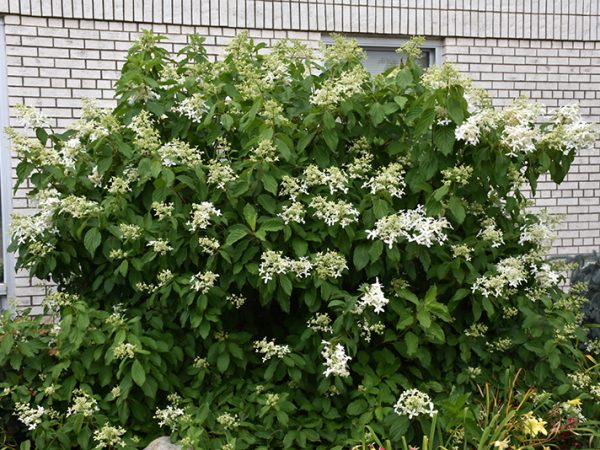
Hydrangea paniculata great star
Layers
The best time for breeding is late autumn. On an adult shrub, choose a flexible branch close to the ground. It is lowered into a trench to a depth of 4-5 cm, dripped with a mixture of garden soil and humus, and watered.
On the eve of autumn frosts, sprinkle with straw, fallen leaves or sawdust.
In the spring, when the snow melts, they dig it up, cut it off from the mother plant, and divide it into parts with roots. The cut sites are treated with a fungicide to avoid infection. Seated in a garden or flower garden.
Cuttings
Cuttings with two internodes are chosen at the top of the bush in spring or autumn, cut at a height of 20 cm at an angle of 45 °. Before planting, they are dipped into one of the root formation stimulants for half an hour. After this time, they are planted in a mixture of peat and sand to a depth of 5 cm.
Placed in a warm place, moisturize regularly for 1.5 months. Then they are planted in open ground.
Diseases and pests
Due to improper planting, a sharp change in the frequency of watering, stagnant moisture in the roots and a lack or excess of nutrients, the Great Star panicle hydrangea begins to hurt.
Chlorosis
The reason is the lack of iron in the soil. Signs - foliage and stems first turn pale, then turn yellow, while the veins remain green.
To eliminate the problem, it is necessary to spray the bush with Ferovit, Antichlorosis, Chelate or Agricol.
If the plant is severely affected, copper sulfate or potassium nitrate should be added under the root.
White rot
This fungal infection starts from the beginning in the roots, then, at an advanced stage, passes to the crown. The leaves and shoots are covered with brown spots. On a diseased shrub, all infected organs are removed, treated with Fitosporin.
Heavily damaged specimens are dug up, burned, the hole is spilled with a solution of copper sulfate or potassium permanganate.
Gray rot
This disease is rapidly spreading to all parts of the bush.They become watery and soft, holes form on the foliage. In wet and rainy weather, the fungus can destroy the entire bush in a short time.
Sore spots are cut off, after which the crown is irrigated with Fundazol.
Powdery mildew
You can identify this sore by the white oily bloom on the leaves and stems. With a minor lesion, you can cure a fungal infection with a solution of laundry soap (150 g) and copper sulfate (20 g) per 10 liters of water.
The advanced stage is treated with chemistry - Skor, Topaz or Cumulus.
Spider mite
A small insect envelops the underside of the leaves with a small cobweb, feeds on their juice, as a result of which a marble pattern appears on the surface. Actellik or Aktara will help get rid of the parasite.
Aphid
This pest, like the previous one, sucks the juices from all young organs. Leaves curl, dry and fall off. In the treatment, folk remedies are used - they irrigate the crown with an ash-and-soap solution, infusion of tobacco or garlic.
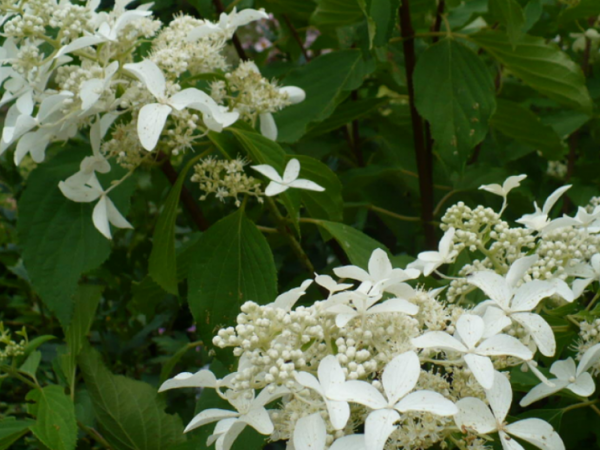
Hydrangea paniculata great star description
If it does not help, they resort to chemistry - they spray it with Karbofos, Fitoverm, Tanrek or Commander.
Snails and slugs
The buds are eaten out, which leads to a loss of decorativeness of the hydrangea. Collecting pests is carried out in spring and autumn when they are massively accumulated in the root area. To prevent further occurrence, the trunk circle is sprinkled with coniferous sawdust, wood ash or special granules.
Gall nematode
This insect infects the root system, so it is very difficult to immediately detect it. If the leaves, flowers and stems begin to wither quickly, then the hydrangea is affected by a nematode. It is impossible to get rid of it, but for prevention, it is recommended to treat the rhizome and soil with a solution of copper sulfate before planting.
Application in garden design
Great Star versatile litter looks great in both single and group plantings and is often planted along ponds for a distinctive and textured look.
The shrub, planted in the center of the green lawn, looks beautiful. Looks good in a composition with roses, rhododendrons, dwarf conifers.
For zoning a plot, hydrangeas are planted in strips in combination with other varieties.
Testimonials
According to many gardeners, hydrangea should be in every garden:
- tolerates pruning well, is not afraid of frost, rarely gets sick with good care;
- with the help of cuttings and stem layers, it is possible to get many new seedlings with all the varietal characteristics of the mother bush;
- grows well in combination with other ornamental vegetation in the garden, without creating competition for them for moisture and nutrients, the main thing is only to maintain the required distance when planting.

